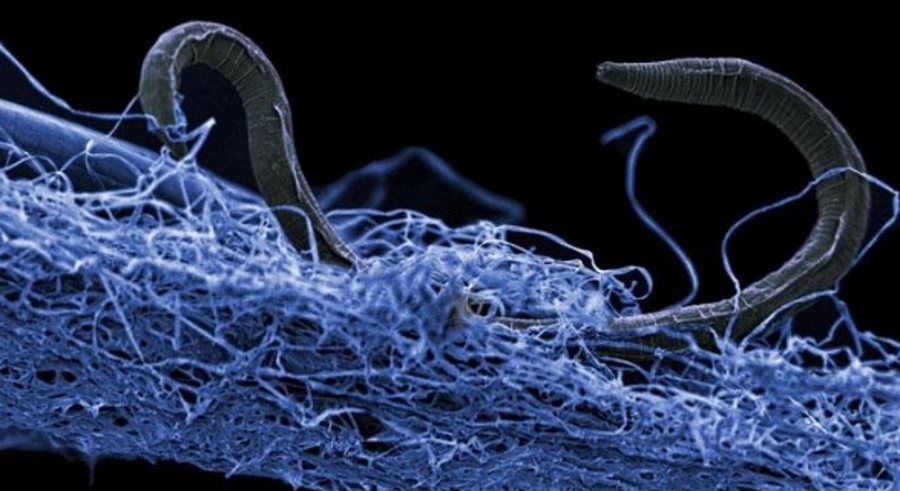Deep underground, an unknown world has been discovered. A kingdom of microorganisms larger than the mass of humanity
Deep underground there is a huge ecosystem whose mass is far greater than the mass of life found on the surface of our planet. Researchers at the Deep Carbon Observatory are just beginning to explore this subterranean world and are surprised by its diversity.
Deep beneath our feet exists a vast and róA diverse biosphere thatórą scientists are just beginning to learn. Microbes balancing on the border between life and death, barely moving microorganisms, function under extreme conditions: high temperatures, lack of light, poor availability of componentóin nutrients and enormous pressures.
Scientists estimate that the underground biosphere of carbon-based life has 15 to 23 billionóin the ton. This is several hundred times more than the biomass of humanity living on the Earth’s surface.
Scientists gathered at the Deep Carbon Observatory are behind the study. This is a global research program aimed at better understanding the role of carbon on our planet. They claim that róspecies diversityóIn the underground world, one can porótion to that found in the Amazon or Galapagos Islands, but unlike those places, the discovered environment is still largely pristine.
– It’s like finding a whole new source ofódations of life on Earth,” said Professor Karen Lloyd of the University of Tennessee. – So much life is found inside the Earth, not above it. We discover new types of life all the time – added.
In this underground crólestwo is dominated by bacteria and archaeons, whichóre very róare different from their cousinsów from the surface. W¶ród of them are millions of distinct typesóin, whichóre have not yet been thoroughly studied and characterized. Scientists have named this biosphere „microbial dark matter". It broadens our perspective on life on our planet.
Deep Carbon Observatory brings together 1,200 scientistsów of 52 countryóin the world. The project involves scientists from rósive areas. From geology and microbiology to chemistry and physics. A year before the conclusion of their 10-year study, they presented their findings to date before the American Geophysical Union’s annual meeting, which is about to begin.
Próbki, on whichórych scientists based their revelations were taken from many boreholesów, with któhe deepest ones reached depths of more than 5 kilometersów. The material for the study was obtained róalso from underwater boreholesów to construct models of the ecosystem and estimate how much carbon it might contain.
The findings suggest that 70 percent of. terrestrial bacteria and archaeonów lives beneath the earth’s surface. They are among theód them microorganisms such as Altiarchaeales, które live in sulfurous environments or Geogemma barossii, unicomórk organisms found in the vicinity of chimneysóin hydrothermal vents at the bottom of the sea, where the temperature is 121 degrees Celsius.
One of the organisms discovered in the studyóin was found at a depth of about 2.5 kilometers. There is no way to draw energy from the sun. Instead, this methanogen benefits from the oxidation of inorganic substances. The environment, in whichórim of life forces it to use its energy not for reproduction, but for rebuilding the componentóin the comórkowe and sustaining their existence.
– The strangest thing to me is that someóre organisms may have existed there for millennia. They are metabolically active, but at a standstill, with less energy than we previously thought sufficient to support life – explained Lloyd.
Rick Colwell of Oregon State University, admitted that the time scale of underground life completely róvary from our understanding. Someóre of these microorganismsów have lived for thousands of years, barely moving except for movementóin tectonic plates or during earthquakes.
– We humans orient ourselves to relatively fast processes. Sun-based diurnal cycle or Moon-based lunar cycles. These organisms orient their life cycles in an almost geological time frame – explained Colwell.
Underground biospheres róThey vary according to geology and geography. Their total size is estimated at more than 2 billion metersóin cubic. But these are preliminary estimates, whichóre will probably be further expanded in the future.
The researchers’ discoveries were made possible by dwóm technological advances. This is primarily about new drilling techniques, whichórym can be downloaded próbki from previously unreachable depths. The second key advance enabling this research is the development of theój microscopic techniques, które allowing the detection of life at lower and lower levels.
Scientists prób are to determine the depth, the limit for whichórym life cannot exist, but the deeper they dig, the more life they find. The current record is 5 kilometersóin the depths. In terms of temperature and pressure róAlso, changes are still taking place. Currently, the highest temperature at whichówhere life has been found (the aforementioned Geogemma barossii) is currently 121 degrees C., but scientists are confident that if they continue to explore the underground world using the most sophisticated instrumentsów, this record will be broken.
It remains a mystery whether life colonized the Earth from the subterranean depths, or whether it descended from the surface to the underground. Researchers also don’t know how these microorganisms cope in this unknown world and through what chemical processes, and what this might tell us about the evolution of life on Earth.
Scientists admitted that someóre discoveries enter the realm of philosophy and exobiology – the study of extraterrestrial life. – We must ask ourselves, if life on Earth can be so ródifferent from what we expected based on our experience, then what exoticism awaits us when we start looking for life on other worlds? – said Robert Hazen of the Carnegie Institution for Science.
– Exploring the deep biosphere is similar to exploring the Amazon rainforest. There is life everywhere and there is an astonishing abundance of unexpected and unusual organisms everywhereów – estimated Mitch Sogin of the Woods Hole Marine Biological Laboratory in the US.
SourceóSource: The Guardian, Deep Carbon Observatory, photo. Gaetan Borgonie, Extreme Life Isyensya

